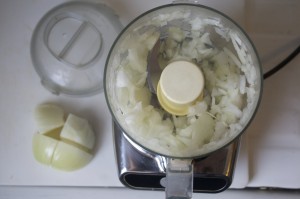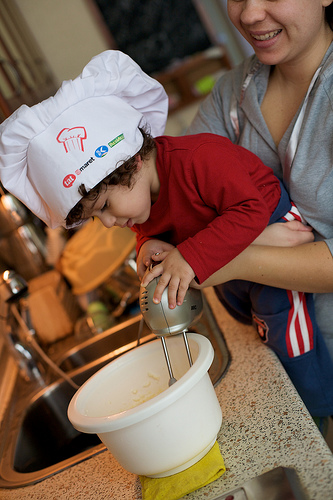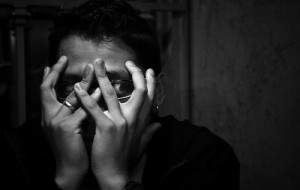If you’re new to the kitchen—or struggling to manage the work-family juggle—the idea of cooking from scratch regularly can feel daunting.
Until it becomes routine, meal preparation may seem complex and confusing: Planning. Timing. Locating the right pots, pans and utensils. Not to mention clean up.
Maybe the mere thought of a post-explosion, after-dinner kitchen alone has you picking up the phone and dialing for take-out.
But relax.
With practice, scratch cooking soon becomes faster, easier—and a lot more fun. To help you ease into the kitchen, take advantage of the following tips, shortcuts and suggestions collected by Copywriter’s Kitchen.
And please. Don’t stress trying to incorporate all suggestions at once. Peruse tips, choose what you like and lose the rest.
Today’s post includes 12 tips. An additional 18 suggestions follow tomorrow.
Organize and plan ahead
If you haven’t yet, you may want to check out Copywriters’ Kitchen’s Boy Scout’s Guide to Scratch Cooking: Be Prepared for additional plan-ahead suggestions.
- Plan a weekly menu. Before you grocery shop, envision the week ahead. Do you have a deadline at work? Busy with kids’ sports? A community or volunteer commitment? Maybe this week you need to serve a few FAST food meals or Under 30-Minute Dinners. Plan a menu now and avoid midweek madness later. Need dinner ideas? Check Copywriters’ Kitchen Weekly Menu every Monday, or see archived recipes and menus.
- Jot down a grocery list—preferably on the same page you’ve written your menu. Think through each meal and note all ingredients you need, including vegetables, salad fixings, breads and other sides.
- Keep your pantry stocked with Frugal Foodie staples. Include a variety of dried beans and pastas, canned tomatoes, nuts and long-keeping vegetables such as onions, garlic, carrots and potatoes. I always feel comfiest with doubled-up essentials: two cans of Italian tomatoes, two bags of pinto beans, etc. Scan kitchen shelves and note missing items before venturing forth to shop.
- Shop once a week. At Copywriters’ Kitchen we try to buy food directly from farmers and family-owned markets, seek out ethically-raised meat and avoid chain supermarkets. How do we manage it with busy work, school and family schedules? We make it a rule to shop once a week. By batching a multi-stop grocery run with other errands—cleaners, shoe repair—we blitz through shopping in a single day, usually Saturday morning. By “we” I mean my husband—the grocery shopper at Copywriters’ Kitchen. If you’re trying to plan meals, shop, scratch cook and clean up all by yourself, stop. And be sure to come back tomorrow to read the last item of the post.
- Arrange your kitchen for maximum convenience. Whether you have a stadium-sized kitchen, or a tiny galley like mine, in order to scratch cook regularly, you need to organize your kitchen for maximum accessibility. You don’t have to be a feng shui master to identify your kitchen’s energy-draining inefficiencies. Take a deep breath and think about how you work and move while cooking. Maybe—just a suggestion—you don’t need your mom’s 1970’s Salton yogurt maker, Grandma’s copper cannelé mold and the $15 cappuccino maker you nabbed at the garage sale. At your fingertips. Every day. Clear your space and your head so you can actually get stuff done in the kitchen.

Process and prepare: Your kitchen as home-factory
Ah, you’re home from the grocery store. Eco-friendly grocery bags jam your kitchen counters and make the floor impassable. Well-done, urban/suburban hunter-gatherer.
Ready to open a beer and kick back for the rest of the day? Not quite.
To undergo transformation into body-and-soul-nourishing food, those unpacked groceries—raw commodities—need to be divided, packed, organized and stored. Delay gratification: Make an effort now and you’ll enjoy leisurely home-cooked meals through the week.
- Cut up and store meat in meal-sized portions. At Copywriters’ Kitchen we buy grass-fed meat in bulk from farmers we know. But some family members are vegetarian—so we cook small portions of meat. How do we accommodate this incongruity? As soon as bulk meat and whole chickens come into the kitchen, we divide them into meal-sized portions, pack and freeze. Thinking of throwing all the bulk meat in the freezer and dealing with it later? Not recommended. Thawing, cutting up, dividing and refreezing 20 pounds of frozen burger and six rock-hard whole chickens is more labor-intensive than you imagine. As we learned the hard way.
- Bulk wash and store salad greens. You don’t need to rely on expensive pre-made salads from the grocery store in order to whip out fresh dressed greens every night. Instead, advance-prep and store your own pre-mixed salads. Wash and tear greens into bite-sized pieces, cut scallions and other non-juicy veggies, and whirl in a salad spinner. Line an air-tight food storage container—I prefer glass storage—with a paper towel or clean cloth and fill with salad greens. Put another paper towel or cloth over greens and cover tightly with lid. Well-stored refrigerated greens will last almost as long as purchased pre-mixed salads—at a fraction of the cost.
- Cook and store beans. Those healthy, delicious pintos, white beans and split peas are no good to you dried on a busy weeknight when the kids are wailing and you need dinner in 15 minutes. Cook the beans now. If you have a Crockpot—highly recommended—your labor takes two minutes. Wash and pick over beans, put in Crockpot, add salt if desired, cover with water and turn on the Crockpot. In 2-3 hours you have perfectly cooked, non-mushy beans that cost about 5 cents a serving. Stove-top cooking takes a little more concentration—follow directions on bean package.
Time-saving appliances: Speed the plow—or the microwave
I’m not a huge fan of electronic kitchen gadgets: I use a hand-crank can opener and a hand-held mixer. I don’t own an electric rice cooker, griddle, deep fryer or food grill. I do, however, rely on a few key appliances. Without these mechanical helpers, I couldn’t pull off easy, scratch-cooked meals every night. You, too, may want to…
- Nuke judiciously. While taste and safety concerns keep me from long-time microwave cooking, I rely on a microwave oven to soften butter, melt chocolate, warm maple syrup and pulse-thaw meats and other frozen victuals. Please promise you won’t nuke food in plastic: use Pyrex dishes, tempered glass measuring cups and glass food containers instead.
- Let your Crockpot think for you. Likely you already know a Crockpot saves you labor. What you may not realize is how it frees you to be a mindless idiot in the kitchen. If you’ve ever scorched a $270 Staub Dutch oven or repeatedly blackened a stockpot, you don’t undervalue the benefits of mindless hands-off slow cooking. It’s like having a kitchen gnome: Your Crockpot does 95% of the labor, you log in a full workday, skip into the kitchen, stir twice and get credit for whipping out luscious hummus, chili, burritos, soups, stews and—as we copywriters say—much, much more.
- Food process creatively: Yes, I use my food processor to purée and blend. But I also rely on it to chop, mince and grate—especially when double-batching recipes and preparing large ingredient quantities for entertaining or advance prep. My mini-chopper is the single most-used appliance in my kitchen. It chops single onions, minces garlic, rough-cuts canned tomatoes, makes Caesar and other salad dressing, grinds nuts, purées small quantities of sauce-thickening vegetables and more.
- Get your hands on some dough—with a bread machine. Some cooks find it meditative to pommel and knead dough. Pas moi. I do, however, adore hot-from-the-oven whole-grain breads and fresh pizza dough. A bread machine makes it all possible. You throw in ingredients, push a button and come back a few hours later to kneaded, proofed, risen and ready-to-bake dough. You don’t have to spend a fortune on a bread machine. I bought mine for under $50—and you can often cadge like-new machines at garage sales or ebay for under $20.

Photo courtesy of: Tasslehoff Burrfoot






